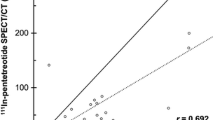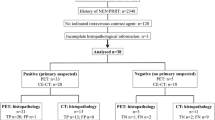Abstract
Objectives
To compare the diagnostic performance of 68Ga-DOTATOC PET/MRI and 68Ga-DOTATOC PET/CT in the whole-body staging of patients with neuroendocrine tumours (NET).
Methods
Thirty patients with histopathologically confirmed NET underwent PET/CT and PET/MRI in a single-injection protocol. PET/CT and PET/MRI scans were prospectively evaluated with regard to lesion count, localization, nature (NET/non-NET), and conspicuity (four-point scale). Histopathology and follow-up imaging served as the reference standards. The proportions of NET and non-NET lesions rated correctly were compared using McNemar’s chi-squared test. The Wilcoxon test was used to assess differences in SUVmax and lesion conspicuity. The correlation between the SUVmax for the same lesions from each modality was analysed using Pearson’s correlation coefficient (r).
Results
According to the reference standard, there were 197 lesions (142 NET, 55 non-NET). Lesion-based analysis showed a higher proportion of correctly rated NET lesions on PET/MRI than on PET/CT (90.8% vs. 86.7%, p = 0.031), whereas on PET/CT there was a higher proportion of correctly rated non-NET lesions (94.5% vs. 83.6%, p = 0.031). SUVmax was strongly correlated (r = 0.86; p < 0.001) and did not differ significantly (p = 0.35) between the modalities. Overall conspicuity and NET lesion conspicuity were higher on PET/MRI (both p < 0.01).
Conclusions
Ga-DOTATOC PET/MRI yielded a higher proportion of correctly rated NET lesions and should be regarded as a valuable alternative to 68Ga-DOTATOC PET/CT in whole-body staging of NET patients.
Key Points
• 68 Ga-DOTATOC PET/MRI correctly identified more NET lesions than 68 Ga-DOTATOC PET/CT.
• 68 Ga-DOTATOC PET/MRI provides better NET lesion conspicuity than 68 Ga-DOTATOC PET/CT.
• SUVmax values from the two modalities are strongly correlated and do not differ significantly.




Similar content being viewed by others
References
Klimstra DS, Beltran H, Lilenbaum R, Bergsland E (2015) The spectrum of neuroendocrine tumors: histologic classification, unique features and areas of overlap. Am Soc Clin Oncol Educ Book 92–103. doi:10.14694/EdBook_AM.2015.35.92
Yao JC, Hassan M, Phan A et al (2008) One hundred years after "carcinoid": epidemiology of and prognostic factors for neuroendocrine tumors in 35,825 cases in the United States. J Clin Oncol 26:3063–3072
Oberg K, Eriksson B (2005) Endocrine tumours of the pancreas. Best Pract Res Clin Gastroenterol 19:753–781
Skoura E, Michopoulou S, Mohmaduvesh M et al (2016) The impact of 68Ga-DOTATATE PET/CT imaging on management of patients with neuroendocrine tumours: experience from a national referral centre in the United Kingdom. J Nucl Med 57:34–40
Kulaksiz H, Eissele R, Rossler D et al (2002) Identification of somatostatin receptor subtypes 1, 2A, 3, and 5 in neuroendocrine tumours with subtype specific antibodies. Gut 50:52–60
Kaemmerer D, Peter L, Lupp A et al (2011) Molecular imaging with 68Ga-SSTR PET/CT and correlation to immunohistochemistry of somatostatin receptors in neuroendocrine tumours. Eur J Nucl Med Mol Imaging 38:1659–1668
Krenning EP, Bakker WH, Breeman WA et al (1989) Localisation of endocrine-related tumours with radioiodinated analogue of somatostatin. Lancet 1:242–244
Hofman MS, Lau WF, Hicks RJ (2015) Somatostatin receptor imaging with 68Ga DOTATATE PET/CT: clinical utility, normal patterns, pearls, and pitfalls in interpretation. Radiographics 35:500–516
Treglia G, Castaldi P, Rindi G, Giordano A, Rufini V (2012) Diagnostic performance of gallium-68 somatostatin receptor PET and PET/CT in patients with thoracic and gastroenteropancreatic neuroendocrine tumours: a meta-analysis. Endocrine 42:80–87
Hope TA, Pampaloni MH, Nakakura E et al (2015) Simultaneous 68Ga-DOTA-TOC PET/MRI with gadoxetate disodium in patients with neuroendocrine tumor. Abdom Imaging 40:1432–1440
Beiderwellen KJ, Poeppel TD, Hartung-Knemeyer V et al (2013) Simultaneous 68Ga-DOTATOC PET/MRI in patients with gastroenteropancreatic neuroendocrine tumors: initial results. Investig Radiol 48:273–279
Beiderwellen K, Grueneisen J, Ruhlmann V et al (2015) [(18)F]FDG PET/MRI vs. PET/CT for whole-body staging in patients with recurrent malignancies of the female pelvis: initial results. Eur J Nucl Med Mol Imaging 42:56–65
Grueneisen J, Schaarschmidt BM, Heubner M et al (2015) Implementation of FAST-PET/MRI for whole-body staging of female patients with recurrent pelvic malignancies: a comparison to PET/CT. Eur J Radiol 84:2097–2102
Geijer H, Breimer LH (2013) Somatostatin receptor PET/CT in neuroendocrine tumours: update on systematic review and meta-analysis. Eur J Nucl Med Mol Imaging 40:1770–1780
Spick C, Herrmann K, Czernin J (2016) 18F-FDG PET/CT and PET/MRI perform equally well in cancer: evidence from studies on more than 2,300 patients. J Nucl Med 57:420–430
Schreiter NF, Nogami M, Steffen I et al (2012) Evaluation of the potential of PET-MRI fusion for detection of liver metastases in patients with neuroendocrine tumours. Eur Radiol 22:458–467
Beiderwellen K, Huebner M, Heusch P et al (2014) Whole-body [18F]FDG PET/MRI vs. PET/CT in the assessment of bone lesions in oncological patients: initial results. Eur Radiol 24:2023–2030
Schmidt GP, Schoenberg SO, Schmid R et al (2007) Screening for bone metastases: whole-body MRI using a 32-channel system versus dual-modality PET-CT. Eur Radiol 17:939–949
Sawicki LM, Grueneisen J, Buchbender C et al (2016) Comparative performance of 18F-FDG PET/MRI and 18F-FDG PET/CT regarding detection and characterization of pulmonary lesions in 121 oncologic patients. J Nucl Med 57:582–586
Rauscher I, Eiber M, Furst S et al (2014) PET/MR imaging in the detection and characterization of pulmonary lesions: technical and diagnostic evaluation in comparison to PET/CT. J Nucl Med 55:724–729
Schwenzer NF, Seith F, Gatidis S et al (2016) Diagnosing lung nodules on oncologic MR/PET imaging: comparison of fast T1-weighted sequences and influence of image acquisition in inspiration and expiration breath-hold. Korean J Radiol 17:684–694
Durante C, Boukheris H, Dromain C et al (2009) Prognostic factors influencing survival from metastatic (stage IV) gastroenteropancreatic well-differentiated endocrine carcinoma. Endocr Relat Cancer 16:585–597
Riihimaki M, Hemminki A, Sundquist K, Sundquist J, Hemminki K (2016) The epidemiology of metastases in neuroendocrine tumors. Int J Cancer 139:2679–2686
Lombard-Bohas C, Mitry E, O'Toole D et al (2009) Thirteen-month registration of patients with gastroenteropancreatic endocrine tumours in France. Neuroendocrinology 89:217–222
Quick HH (2014) Integrated PET/MR. J Magn Reson Imaging 39:243–258
Author information
Authors and Affiliations
Corresponding author
Ethics declarations
Guarantor
The scientific guarantor of this publication is Ass. Prof. Dr. med. Lale Umutlu.
Conflict of interest
The authors of this manuscript declare no relationships with any companies, whose products or services may be related to the subject matter of the article.
Funding
The authors state that this work did not receive any funding.
Statistics and biometry
One of the authors has significant statistical expertise.
Ethical approval
Institutional Review Board approval was obtained.
Informed consent
Written informed consent was obtained from all patients in this study.
Study subject or cohort overlap
None of the study subjects or cohorts has been previously reported.
Methodology
• Prospective
• Diagnostic study
• Performed at one institution
Rights and permissions
About this article
Cite this article
Sawicki, L.M., Deuschl, C., Beiderwellen, K. et al. Evaluation of 68Ga-DOTATOC PET/MRI for whole-body staging of neuroendocrine tumours in comparison with 68Ga-DOTATOC PET/CT. Eur Radiol 27, 4091–4099 (2017). https://doi.org/10.1007/s00330-017-4803-2
Received:
Revised:
Accepted:
Published:
Issue Date:
DOI: https://doi.org/10.1007/s00330-017-4803-2




